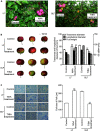Endogenous Auxin Content Contributes to Larger Size of Apple Fruit
- PMID: 33519848
- PMCID: PMC7841441
- DOI: 10.3389/fpls.2020.592540
Endogenous Auxin Content Contributes to Larger Size of Apple Fruit
Abstract
Fruit size is an important economic trait that is controlled by multiple genes. However, the regulatory mechanism for fruit size remains poorly understood. A bud sport variety of "Longfeng" (LF) apple (Malus domestica) was identified and named "Grand Longfeng" (GLF). The fruit size of GLF is larger than that of LF, and both varieties are diploid. We found that the cell size in GLF fruit was larger than that of LF. Then, we compared the fruit transcriptomes of the two varieties using RNA-Seq technology. A total of 1166 differentially expressed genes (DEGs) were detected between GLF and LF fruits. The KEGG analysis revealed that the phytohormone pathway was the most enriched, in which most of the DEGs were related to auxin signaling. Moreover, the endogenous auxin levels of GLF fruit were higher than those of LF. The expressions of auxin synthetic genes, including MdTAR1 and MdYUCCA6, were higher in GLF fruit than LF. Collectively, our findings suggest that auxin plays an important role in fruit size development.
Keywords: MdTAR1; MdYUCCA6; apple; auxin; cell size; fruit size.
Copyright © 2020 Bu, Yu, Yuan, Yue, Wei and Wang.
Conflict of interest statement
The authors declare that the research was conducted in the absence of any commercial or financial relationships that could be construed as a potential conflict of interest.
Figures






References
-
- Cruz-Castillo J., Woolley D., Lawes G. (2002). Kiwifruit size and CPPU response are influenced by the time of anthesis. Sci. Horticult. 95 23–30. 10.1016/S0304-4238(01)00384-3 - DOI
LinkOut - more resources
Full Text Sources
Other Literature Sources

